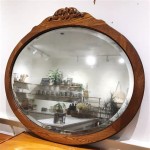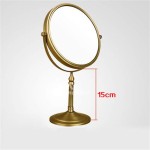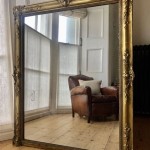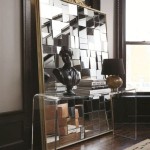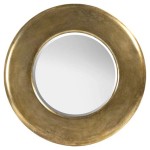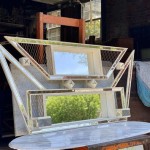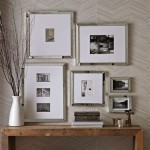Installing a Bathroom Mirror on Tiles
Installing a bathroom mirror directly onto tiles presents a unique set of challenges. The smooth, non-porous surface of tile offers little for adhesives to grip, requiring specific techniques and materials to ensure a secure and lasting installation. This article will outline the necessary steps and considerations for successfully mounting a mirror on a tiled bathroom wall.
Planning and Preparation: Accurate measurements are crucial. Measure the mirror's dimensions and the desired location on the tiled wall. Mark the mirror's outline on the tile using a level and a pencil or masking tape to ensure straight and even placement. Consider the placement of existing fixtures, such as light switches and electrical outlets.
Choosing the Right Adhesive: Standard mirror adhesives may not be suitable for tile applications. Opt for a high-strength, neutral-cure silicone adhesive specifically designed for mirrors and heavy objects on non-porous surfaces. These adhesives offer superior bonding strength and are resistant to moisture and temperature fluctuations common in bathroom environments. Avoid using acidic silicone sealants, which can damage the mirror backing.
Surface Preparation: Clean the tiled surface thoroughly with a suitable tile cleaner to remove any soap scum, grease, or residue. Rinse the area with clean water and allow it to dry completely. For optimal adhesion, lightly sand the area on the tile where the mirror will be mounted with fine-grit sandpaper. This creates a slightly roughened surface for the adhesive to grip. Wipe away any dust created by sanding.
Applying the Adhesive: Depending on the size and weight of the mirror, apply the adhesive either in a continuous bead around the perimeter of the mirror's back or in vertical lines spaced evenly across the back surface. Leave a gap of approximately one inch between the adhesive and the edge of the mirror to prevent squeeze-out. For heavier mirrors, consider using mirror clips or mounting brackets in addition to the adhesive for extra support.
Positioning and Securing the Mirror: Carefully position the mirror onto the marked area on the tile. Apply even pressure across the mirror's surface to ensure proper contact with the adhesive. Use shims or spacers, if necessary, to maintain even gaps around the mirror's edges. These spacers will also prevent the mirror from sliding down while the adhesive cures.
Supporting the Mirror during Curing: The adhesive typically requires several hours to cure fully. During this time, it is essential to support the mirror to prevent slippage. Use masking tape to secure the mirror to the wall, or utilize temporary supports, such as wooden blocks or props, placed beneath the mirror's bottom edge.
Finishing Touches: After the adhesive has cured completely, carefully remove any temporary supports or masking tape. Clean any excess adhesive that may have squeezed out from around the mirror's edges using a razor blade or a specialized adhesive remover. Finally, apply a thin bead of neutral-cure silicone sealant around the perimeter of the mirror where it meets the tile. This creates a waterproof seal and prevents moisture from getting behind the mirror, potentially damaging the wall or the mirror backing.
Heavy or Oversized Mirrors: For exceptionally heavy or oversized mirrors, consider using a mechanical fastening system in conjunction with adhesive. This may involve drilling holes through the tile and using specialized anchors to secure the mirror to the wall. Consult a professional for guidance on appropriate anchoring methods for your specific tile type and wall structure.
Safety Precautions: Always wear appropriate safety gear, including safety glasses and gloves, when working with adhesives, sealants, and power tools. Follow the manufacturer's instructions carefully for all materials and tools used in the installation process. If unsure about any aspect of the installation, consult a qualified professional.
Alternative Mounting Methods: For those hesitant to use adhesives directly on tiles, alternative mounting methods exist. Mirror mounting clips, often used in conjunction with adhesive, provide added support. J-channels, or mirror clips that attach to the wall and grip the edges of the mirror, offer another option, although they may require more precise measurements and alignment. Consult a hardware professional for advice on suitable alternatives based on the mirror's size and weight.
Tile Considerations: The type of tile can also impact the installation process. Highly polished or glazed tiles may require more aggressive surface preparation, such as sanding or etching, to improve adhesion. Porous tiles, such as unglazed ceramic or natural stone, may absorb moisture and require a different type of adhesive or sealant. Research the specific requirements for your tile type before beginning the installation.

How To Hang Mirrors On Tile 3 Ways A Bonus The Palette Muse

How To Hang Mirrors On Tile 3 Ways A Bonus The Palette Muse

How To Hang A Mirror On Tile Wall Remington Avenue

How To Hang A Bathroom Mirror Over Tile Wainscoting Mimzy Company

Diy Mosaic Tile Bathroom Mirror Centsational Style

Tutorial How To Hang A Bathroom Mirror The Diy Playbook

Tutorial How To Hang A Bathroom Mirror The Diy Playbook

Diy Mosaic Tile Bathroom Mirror Centsational Style

Diy Mosaic Tile Bathroom Mirror Centsational Style

How To Hang Install A Bathroom Mirror By Mira Showers

